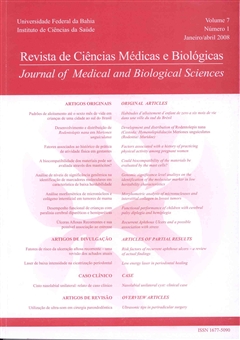Low energy laser in periodontal healing
DOI:
https://doi.org/10.9771/cmbio.v7i1.4362Keywords:
Periodontal treatment, Periodontal tissue healing- Low energy laser therapy, Low energy laser- Periodontal tissue healing.Abstract
The aim of this study was to analyse the results and the methodology of the studies about the potential effects of low energy laser (LEL) irradiation on the healing of the periodontal tissue, using databases of MEDLINE between 1992 to 2007. Basically, 2 types of low energy laser are utilized: Helium Neon (HeNe), with wavelength of 633nm and diodo lasers like Gallium-Aluminium-Arsenide (AsGaAl), Gallium-Arsenide(AsGa) and Indium- Gallium- Aluminium-Phosphide (InGaAlP) whose wavelength range between 635-950 nm. A total of 59 studies were observed and whitin these, 9 were selected and show that LEL is associated with healing, because of its potencial to reduce the local levels of prostaglandin; to increase the levels of beta endorphin; to estimulate the production of cellular ATP and the discharge of growth factors; as well as the cellular proliferation and collagen synthesis; and the decrease of bleeding of probing . These findings suggest that, the LEL seems to benefit the process of tissue healing. However, the analysis of the studies and a sugestion to use LEL are dificult because of the diversity of methodology, such as differences between wavelength, dosimetry, and the type and the design of the studies.Downloads
Download data is not yet available.
Downloads
Published
2008-10-16
How to Cite
Barros, F. C. de, Antunes, S. A., Figueredo, C. M. da S., & Fischer, R. G. (2008). Low energy laser in periodontal healing. Journal of Medical and Biological Sciences, 7(1), 85–89. https://doi.org/10.9771/cmbio.v7i1.4362
Issue
Section
Artigo de Atualização
License
The Journal of Medical and Biological Sciences reserves all copyrights of published works, including translations, allowing, however, their subsequent reproduction as transcription, with proper citation of source, through the Creative Commons license. The periodical has free and free access.


